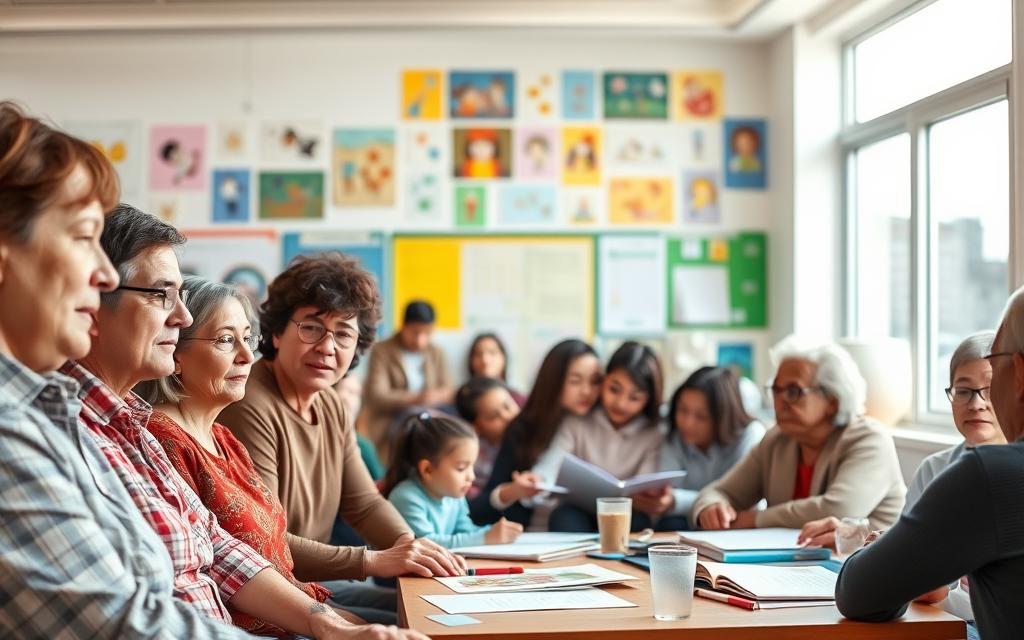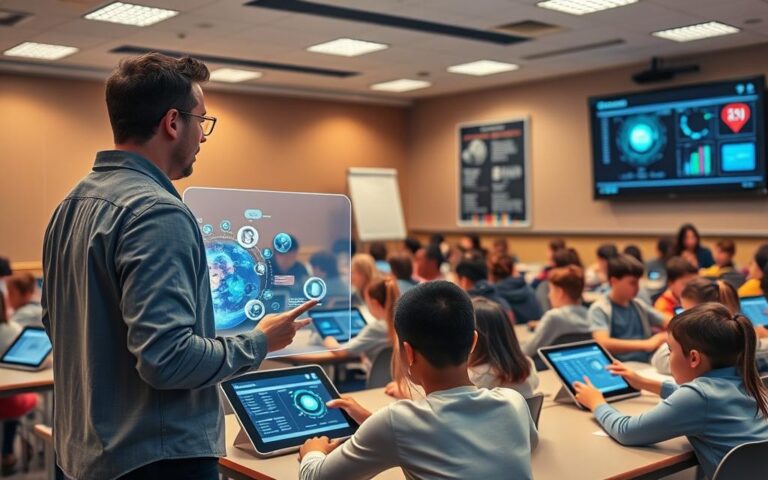Did you know nearly half the students in the U.S. are in schools where less than 5% excel in math? This fact shines a light on the ongoing issue of education inequality. The chance for a good education often depends on your income, race, or where you live. It’s clear we need to fix this gap to give everyone a fair shot.
This article looks at the deep issues of education inequality. We’ll explore its history and what it looks like today. Understanding how this problem started helps us see why we must make learning accessible for all kids.
Understanding Education Inequality
Education inequality is a big challenge in the U.S. It’s about big differences in education and chances to learn. This section talks about what education inequality is, its history, and what it’s like now. We’ll see why this issue is so important.
Definition of Education Inequality
Education inequality means not everyone gets the same resources, help, or chances at school. These differences can show up in many ways. These include the quality of teachers, the condition of schools, and access to extra activities. Because of this, students from less privileged backgrounds often don’t do as well.
Historical Context
Education inequality has deep roots, going back to times of segregation and unfair laws. For years, communities that were pushed to the margins faced barriers to getting a good education. Big court cases, like Brown v. Board of Education, tried to fix some of these problems. Yet, the effects of these historical issues are still felt today.
Current Landscape
The issue of education inequality is still with us. Students from poorer families or communities of color face big challenges. They often go to schools that don’t have enough resources. Things like good teachers and challenging classes are hard to find there. This situation makes the education gap even wider. It’s urgent that we work together to make education fair for everyone.
Factors Contributing to Education Inequality
Education inequality comes from many factors that impact students’ chances and results at school. Knowing the role of things like family income, where you live, and differences in race and culture is key. It helps tackle the school problems many students in America face.
Socioeconomic Status
Kids from families with less money face a lot of challenges in getting a good education. They might not have as many books or tech tools, which leads to a big academic achievement gap. This gap gets bigger over time. Also, parents with less money might not be able to help with homework or after-school activities, making education gaps even wider.
Geographic Disparities
Where schools are located affects the education kids get. City schools may be too full, and country schools might not have enough tools. This makes the education gap bigger between students from different places. The money schools get can be different too, changing what kind of learning and support students can access.
Racial and Ethnic Disparities
Differences in race and culture still cause big problems in education. Teachers might see students differently because of these biases, changing how they teach and support them. Students from different backgrounds may find it harder to learn and do well, which keeps the academic achievement gap going. It’s important to work on these issues to make school fair for everyone.
The Role of Public Funding in Education
Public school funding greatly affects the tools students have for learning. How funds are shared shapes education fairness between districts. Understanding this funding can show the uneven resources among communities.
How Funding is Distributed
Public school funding often comes from local property taxes. As a result, rich areas spend more on their schools. This leads to a gap in funding. Poorer districts get left behind, missing out on new facilities, enough staff, and key learning tools.
Impact on School Resources
Funding gaps cause big differences in school resources across the USA. Rich area schools might have the latest tech and lots of activities. But schools in poorer areas may lack even the basics. This not only reduces student interest but also hurts their future success, keeping the cycle of unequal education going.
The Digital Divide in Education
The digital divide impacts many students in the U.S., blocking fair chances in education. Access to tech is key for online learning, especially during crises like the COVID-19 pandemic. Students without enough tech face big hurdles that slow down their learning.
Access to Technology
Many families, especially in poorer areas, can’t get the tech their kids need for school. This makes the gap in educational tech bigger, making it hard for students to keep up with their studies. Without fast internet and up-to-date devices, participating in online classes becomes really tough, affecting their learning success.
Remote Learning Challenges
Switching to online classes has shown how big the gap in educational tech is. Students with less access to the internet and tech support struggle a lot with online learning. They often feel left out and less engaged, which makes the educational gap even wider among students.
Solutions to Bridge the Gap
To fix the digital divide, we need everyone—governments, schools, and community groups—to work together. Efforts to improve tech access are crucial to close these gaps. By giving out devices and internet to families in need, we can help every student do well in online learning.
The Influence of School Choice
School choice programs are becoming more popular as a different way to learn. They offer choices like charter schools and vouchers. This gives families more control over their kids’ education. These choices can lead to better school experiences but their effects vary in different areas.
Charter Schools and Voucher Programs
Charter schools are unique because they don’t follow the usual public school rules, yet the government still funds them. They focus on special teaching styles or subjects that attract parents looking for something different. Vouchers let parents use government money for private school fees. This gives students a chance to find a school that fits them better, changing how education works.
Pros and Cons of School Choice Initiatives
Supporters say school choice makes schools try harder to be better because they compete. They believe this benefits students from all backgrounds. Critics worry it could take resources away from public schools, making education inequality worse. It’s important to find a balance to ensure education is fair for everyone.
Community Involvement and Its Importance
Getting involved in education strengthens our communities. It tackles educational gaps head-on. Parents and guardians play a crucial role here. Their commitment boosts student learning and support.
When families engage in education, they push for needed resources and services. This helps both students and schools thrive.
Role of Parents and Guardians
Parents and guardians shape children’s academic futures. Their support at home promotes a love for learning. This can lead to better grades in school.
They stand up for their kids, impacting schools and education policies. Thanks to them, schools now encourage parent participation. This makes them vital to the education community.
Community Organizations and Partnerships
Groups outside of school are key to better education. They team up with schools to provide extra services, like tutoring. These partnerships bring more resources and knowledge into classrooms.
This cooperation builds a stronger support system for students. It enhances learning and helps meet the needs of underrepresented students.
| Community Involvement Type | Description | Examples |
|---|---|---|
| Parental Support | Involvement of parents in school activities and advocacy | PTA meetings, volunteering, and fundraising |
| Community Partnerships | Collaboration between schools and local organizations | Tutoring programs, internships, and workshops |
| Educational Resources | Support provided by organizations to enhance learning | After-school programs, mentoring services |

Teacher Support and Training
Teachers play a key role in fighting educational inequality. Good support and training for them can really make teaching better, helping all students. It’s critical to give teachers chances to improve their skills and try new teaching ways.
Professional Development Opportunities
Professional development keeps teachers up-to-date with new teaching methods and tech. It lets them adapt their lessons to fit all students better. Look at these ways for teachers to grow:
- Workshops and seminars focused on new teaching strategies
- Mentoring programs pairing experienced teachers with novices
- Online courses and webinars that provide flexibility in learning
Recruitment and Retention Strategies
Finding and keeping great teachers, especially where they’re needed most, is a big deal. The right strategies can keep a good teaching team together. Here are some ideas:
| Strategy | Description |
|---|---|
| Competitive Salaries | Offering attractive compensation packages to draw in skilled educators. |
| Career Advancement | Providing clear pathways for professional growth, enhancing job satisfaction. |
| Supportive Environment | Cultivating a positive school culture that encourages collaboration and feedback. |
These plans show how important it is to support and train teachers. By doing this, schools can create a better place for teaching and learning.
Impacts of Policy Changes
Changes in education policy deeply affect the American education scene. Recent moves in law aim to make school funding fairer. This attention especially helps schools in poorer areas. Knowing the effects of these changes helps us find what works best in education.
Recent Legislative Efforts
Recently, lawmakers have focused on making school funding more equal. Some major steps they’ve taken include:
- Increased funding for Title I schools
- Expansion of state-level grants for educational resources
- Implementation of universal pre-K programs in various states
These steps aim to fix long-standing unfairness. They make sure every student gets a good education, no matter where they live or their family’s income.
Analysis of Effective Policies
Looking at how new laws have worked shows us which actions are most successful. Important results include:
| Policy Initiative | Impact on Student Performance | Resource Allocation |
|---|---|---|
| Increased School Funding | Higher test scores and graduation rates | Improved access to technology and learning materials |
| Universal Pre-K | Better readiness for kindergarten | Expansion of early childhood education programs |
| School Support Services | Enhanced student mental health and support systems | More counselors and social workers in schools |
These reforms prove that well-chosen policies can really improve schools. They bring better education and more resources to all students.
Mental Health and Academic Success
The link between mental health and doing well in school is clear. Schools focusing on mental health create environments where students feel supported. They are ready to learn. Seeing mental health as key in education leads to amazing educational experiences.
Importance of Mental Wellness
Mental wellness is key for students under academic stress. Unchecked mental health issues can impact focus and participation. This affects their success in school. By adding mental health programs, schools help students become resilient. They learn to handle challenges well. Mental wellness lays the groundwork for successful students and communities.
Programs Supporting Student Mental Health
Wellness programs give students emotional and psychological support. These initiatives include:
- Counseling Services: Offering access to trained professionals who provide guidance and support for students facing various challenges.
- Social-Emotional Learning (SEL): Teaching skills for managing emotions, setting goals, and establishing positive relationships.
- Peer Support Groups: Creating spaces where students can share experiences and learn from each other, fostering community.
- Crisis Intervention Services: Addressing urgent mental health needs promptly to prevent escalation.
Investing in these programs ensures students have the resources for emotional health and academic success.
The Future of Education Equality
The future of education equality looks bright with new trends aiming to close gaps and make learning accessible for everyone. Focusing on technology and personalized learning can meet students’ unique needs. It’s also key to tackle social equity issues as we move forward.
Emerging Trends
New trends in education are pushing for the use of innovative solutions in schools. Technology plays a big role in this change. It provides scalable ways to help students in hard-to-reach areas. Using tech makes learning complex topics easier and more fun for students.
Innovative Solutions on the Horizon
Adaptive learning tech is a major breakthrough in education. It adjusts to each student’s pace based on their performance. Besides, community-based education helps schools and local areas work together. This ensures those hit hardest by educational disparities can influence the solutions provided.
Educators are actively seeking out these fresh approaches, with a strong focus on fair access to resources. Continuous efforts to adopt and keep up with new methods will create a learning environment where every student can thrive. This, in turn, will lead to a stronger society.
Case Studies: Successful Programs
Looking into success stories from different states shows us smart ways to fight education inequality. These stories tell us about special programs designed for the needs of various communities. By working together, these programs have reached great results for students.
Notable Initiatives in Different States
Some states have started programs with big effects, such as:
- California: The “Community Schools Initiative” brings health services into schools to help students in many ways.
- Texas: “Lead4Ward” uses hands-on teaching to make learning more interesting for students.
- New York: The “NYC Empowerment Schools” give schools the chance to decide on their budgets and what they teach to improve themselves.
Lessons Learned from Successful Models
These success stories teach us important lessons for the future:
- When schools and local groups work together, they can do more for students.
- When we carefully choose where to spend money, schools without enough resources do better.
- Getting the community involved builds stronger support for students and their families.
These examples show that thinking differently and involving the community leads to student success. By looking closely at these strategies, we can inspire more education programs. Such programs would be fair for all students across the country.
| State | Program | Focus Area | Impact |
|---|---|---|---|
| California | Community Schools Initiative | Comprehensive Support | Increased student engagement and improved health outcomes. |
| Texas | Lead4Ward | Effective Teaching Strategies | Enhanced student understanding and retention of material. |
| New York | NYC Empowerment Schools | Autonomy in Curriculum | Boosted school performance and parent satisfaction. |
How to Get Involved
Fighting education inequality is key to creating big changes. You can help make a difference whether you’re an individual, family, or part of a community. By talking to local leaders or getting involved in community discussions, you play a big role. You help shape fair education chances for every student.
Advocacy Opportunities
There are many ways to help change education for the better. You might push for fair money and tools for schools, go to community meetings, or join groups focusing on making schools better. By keeping up-to-date and speaking up, you can get leaders to make improvements. Your involvement can lead to a more fair education system for everyone.
Supporting Local Education Initiatives
Helping with local education projects is also a great way to make things fairer. Offer to volunteer at schools or work with groups that are improving education. You could mentor kids or help raise money for important programs. Every bit of help adds up. It makes it easier for all students to get a good education. Together, we can create a brighter future for every student.




